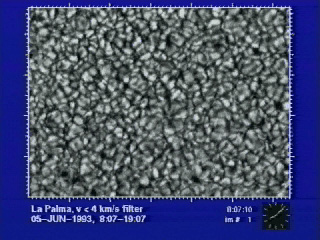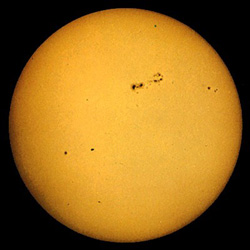Chapter 2. Our Star, The Sun
Overview
Our Star, the Sun: Summary

Most of us think of the Sun as a quiet ball of steadily burning gas that provides the light and heat necessary for life to exist on Earth. As it turns out, our Sun is anything but quiet. Unpredictable explosions on the surface release tons of material that races out into the solar system causing communication satellites to malfunction, power grids on Earth's surface to overload, and the eerie northern and southern lights to glow at high latitudes. Inside the Sun, nuclear fusion operating at 15 million degrees combines hydrogen atoms into larger helium atoms in a process that releases energy that keeps the Sun from collapsing under its own weight.
As it turns out, many of the stars in the night sky are very similar to our Sun. If astronomers can understand the physical mechanisms that cause our Sun to act as it does, then those same principles should apply to the many distant Suns we see in the heavens. Understanding the physical processes that govern our Sun will help us better understand the distant stars twinkling in the night sky.
Alternative presentation (using IFRAME for video, use Preview command to view):
Most of us think of the Sun as a quiet ball of steadily burning gas that provides the light and heat necessary for life to exist on Earth. As it turns out, our Sun is anything but quiet. Unpredictable explosions on the surface release tons of material that races out into the solar system causing communication satellites to malfunction, power grids on Earth's surface to overload, and the eerie northern and southern lights to glow at high latitudes. Inside the Sun, nuclear fusion operating at 15 million degrees combines hydrogen atoms into larger helium atoms in a process that releases energy that keeps the Sun from collapsing under its own weight.
As it turns out, many of the stars in the night sky are very similar to our Sun. If astronomers can understand the physical mechanisms that cause our Sun to act as it does, then those same principles should apply to the many distant Suns we see in the heavens. Understanding the physical processes that govern our Sun will help us better understand the distant stars twinkling in the night sky.
Observation
Our Star, the Sun: Exercise
Determining the Lifetime of a Solar Granule
XXX

Your task is to determine the approximate lifetime of a solar granule on the visible surface of the Sun. Select an area then slowly and rhythmically repeat, "start, stop, start, stop" until you can consistently predict the appearance and disappearance of the cells, called granules. While keeping your rhythm, move to a different area of the video and continue monitoring the appearance and disappearance of granules. When you are confident you have the timing right, move your eyes (or use a partner) to the clock and determine the length of time between the appearance and disappearance of the granules and record your answer here:
Tutorials
Our Star, the Sun: Solar Interior
Considering the Sun's Interior

The image at right shows the Sun's photosphere as seen from Earth's surface. The photosphere is the dense layer of the Sun below which we cannot see. In the space below, describe what you think the interior of the Sun is like using complete sentences. Be as specific as possible about your reasoning of what might be happening to the Sun's luminosity, mass, temperature, and density at the center, near the edge, and half-way in between.
Our Star, the Sun: The Solar Atmosphere
(Content from original AOL site seems to duplicate first page of first tutorial)
Activities
...How Big Are Sunspots?
1. How Big Are Sunspots?
New Paragraph

...Determining the Rotation Rate of the Sun Using X-ray Movies
Examination
Our Star, the Sun: Self Test
Astronomy Online Chapter 18
(20 multiple choice questions follow)